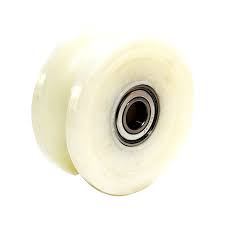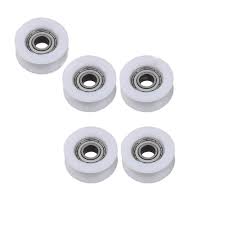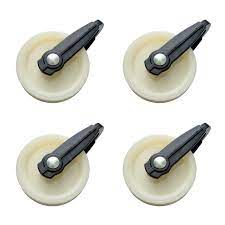Product Description
High quality Casting Oil Nylon Pulley
Mc nylon, means monomer casting nylon, is a kind of engineering plastics used in comprehensive industries, has been applied almost every industrial field.
The caprolactam monomer is first melted, and added catalyst, then poured it inside moulds at atmosphere pressure so as to shape in different castings, such as: Rod, plate, tube. The molecule weight of mc nylon can reach 70, 000-100, 000/mol, 3 times than pa6/pa66. Its mechanical properties are much higher than other nylon materials, such as: Pa6/pa66. Mc nylon plays a more and more important role in the material list recommended by our country.
Since the end of 1980’s, HangZhou engineering plastics industireis company has devoting herself on developing the technology of mc nylon modification, greatly extended the applications in different industries. Basing on the mc nylon, reinforced with variety of additives during the reaction, such as lubricant, molybdenum disulfide, graphite glass fiber, carbon fiber etc, to improve the properties, higher performance of wear-resistance, corrosion-resistance, self-lubrication, vibration-absorption, noise-absorption. At the same time, as the technics and structure of the moulds is quite simple, so that it can be manufactured in lower cost, becomes the ideal substitutes of bronze, stainless steel, babbitt alloy, ptfe and so on.
Oil nylon (green)
Oil nylon(green)is the new engineering plastics that developed by HangZhou engineering plastics industireis company in the later 1980’s by importing the advanced technology from nylacast co., ltd, uk, was the first authentic lubricating nylon that builds the liquid lubricant system during the processing stage, which makes its coefficient of friction is 50% lower than the general pa6 or pa66, the wear-resistance is 10 times than the general ones. Oil nylon is specially developed for the parts of non-self-lubrication, heavy-loading and low-speed-running, which obviously resulted in a substantial increase in bearing life- 5 times that of general pa6 and 25 times that of phosphor bronze! The lubricant contained within the material will not drain, adsorb or dry out and never needs replenishment. The uniform distribution of the lubricant throughout the product guarantees the constant performance of the parts over the whole service life and improvements in rate of wear, sliding frictional properties, abrasion resistance and stick slip performance, which are just a few of the benefits offered by this material. Oil nylon has been successful in considerable enlarging the application of nylon in many industries and specifically for some un-lubricated running parts.
Other casting nylon:
Oil nylon + carbon (black)
Oil nylon added carbon, has the very compact and crystal structure, which is better than the general casting nylon in the performance of high mechanical strength, wear-resistance, anti-aging, uv resistance and so on. It is suitable for making the bearing and other wear mechanical parts.
Oil mc901(blue)
This improved mc nylon, has striking blue color, which is better than general pa6/pa66 in the performance of toughness, flexibility, fatigue-resistance and so on. It is the perfect material of gear, gear bar, transmission gear and so on.
Mc nylon + mso2(light black)
Mc nylon added mso2 can remain the impact-resistance and fatigue-resistance of casting nylon, as well as it can improve the loading capacity and wear-resistance. It has a wide application in making gear, bearing, planet gear, seal circle and so on.
| Property | Item No. | Unit | MC Nylon (Natural) | Oil Nylon+Carbon (Black) | Oil Nylon (Green) | MC90 (Blue) | MCNylon+MSO2(Light Black) | |
| Mechanical Properties | 1 | Density | g/cm3 | 1.15 | 1.15 | 1.135 | 1.15 | 1.16 |
| 2 | Water absorption (23ºCin air) | % | 1.8-2.0 | 1.8-2.0 | 2 | 2.3 | 2.4 | |
| 3 | Tensile strength | MPa | 89 | 75.3 | 70 | 81 | 78 | |
| 4 | Tensile strain at break | % | 29 | 22.7 | 25 | 35 | 25 | |
| 5 | Compressive stress (at 2%nominal strain) | MPa | 51 | 51 | 43 | 47 | 49 | |
| 6 | Charpy impact strength (unnotched) | KJ/m 2 | No brak | No break | ≥50 | No BK | No break | |
| 7 | Charpy impact strength (notched) | KJ/m 2 | ≥5.7 | ≥6.4 | 4 | 3.5 | 3.5 | |
| 8 | Tensile modulus of elasticity | MPa | 3190 | 3130 | 3000 | 3200 | 3300 | |
| 9 | Ball indentation hardness | N/mm 2 | 164 | 150 | 145 | 160 | 160 | |
| 10 | Rockwell hardness | – | M88 | M87 | M82 | M85 | M84 | |
/* January 22, 2571 19:08:37 */!function(){function s(e,r){var a,o={};try{e&&e.split(“,”).forEach(function(e,t){e&&(a=e.match(/(.*?):(.*)$/))&&1
| Material: | PA |
|---|---|
| Size: | According to Drawing or Sample |
| Color: | Natural, White, Black, Green, Blue |
| Tooling: | CNC Lathe |
| Transport Package: | Packing in Paper Carton and Wooden Pallet |
| Specification: | RoHS |
| Customization: |
Available
| Customized Request |
|---|
What is a spinning pulley, and how is it used in mechanical systems?
A spinning pulley is a type of pulley that rotates or spins when subjected to force or power. It is a wheel with a grooved rim designed to guide a rope, belt, or cable, allowing it to change direction and transmit mechanical power. Here’s a detailed explanation of what a spinning pulley is and how it is used in mechanical systems:
A spinning pulley consists of a central hub and a rim or groove around its circumference. The rim is specifically designed to accommodate a rope, belt, or cable, and the groove ensures that the rope or belt remains in place during operation. When force or power is applied to the rope or belt, it causes the spinning pulley to rotate.
In mechanical systems, spinning pulleys are commonly used in conjunction with other pulleys to create a mechanical advantage or to transmit power and motion between different components. Here are some key applications and uses of spinning pulleys:
1. Change Direction of Force:
A spinning pulley can change the direction of force applied to a rope or belt. By routing the rope or belt through the groove of the spinning pulley, the force can be redirected to another location or component in the system. This is particularly useful in applications where the input and output components are not aligned or when flexibility in direction is required.
2. Transmit Power:
Spinning pulleys are often used in power transmission systems to transfer mechanical power from one component to another. By connecting multiple spinning pulleys with ropes or belts, the rotation of one pulley can drive the rotation of another. This allows power to be transferred over distances and around obstacles, enabling the operation of various mechanical devices.
3. Create Mechanical Advantage:
Spinning pulleys are crucial in creating mechanical advantage by utilizing the principle of leverage. By using a combination of different-sized spinning pulleys, mechanical systems can amplify or reduce the force required to perform a particular task. This is achieved by adjusting the relative sizes of the pulleys and the number of times the rope or belt wraps around them.
4. Tensioning and Control:
Spinning pulleys are commonly employed in systems that require tensioning and control of ropes or belts. By adjusting the position and angle of the spinning pulley, the tension in the rope or belt can be controlled. This is important for maintaining proper alignment, preventing slippage, and ensuring efficient power transmission within the mechanical system.
5. Speed Control:
In some mechanical systems, spinning pulleys are used to control the speed of rotating components. By using pulleys of different sizes, the rotational speed can be increased or decreased. This is achieved by changing the ratio of the pulley diameters, which alters the speed at which the rope or belt travels around the pulleys.
Overall, spinning pulleys are essential components in mechanical systems. They enable the redirection of force, transmission of power, creation of mechanical advantage, tensioning and control of ropes or belts, and speed control of rotating components. Their versatility and ability to change the direction of force make them valuable in a wide range of applications, from simple machines to complex industrial systems.
What maintenance procedures are necessary to ensure the reliability of nylon pulleys?
Maintaining nylon pulleys is essential to ensure their reliability over time. Here’s a detailed explanation of the necessary maintenance procedures for nylon pulleys:
- Regular Inspection:
- Perform regular visual inspections of the nylon pulleys to check for any signs of wear, damage, or deformation. Look for cracks, chips, or excessive wear on the pulley surfaces. Inspect the bearings and axles for smooth rotation and proper alignment. Early identification of any issues allows for timely maintenance or replacement, preventing potential failures or disruptions in the system.
- Cleaning:
- Keep the nylon pulleys clean to prevent the accumulation of dirt, dust, or debris. Use a soft brush or cloth to remove any contaminants from the pulley surfaces, bearings, and axles. Avoid using harsh chemicals or solvents that may damage the nylon material. Regular cleaning helps maintain optimal performance by minimizing friction and reducing the risk of premature wear.
- Lubrication:
- Most nylon pulleys are self-lubricating and do not require additional lubrication. However, if the pulleys have bearings or axles, follow the manufacturer’s recommendations for lubrication intervals and use a suitable lubricant. Proper lubrication ensures smooth operation, reduces friction, and extends the lifespan of the pulley components. Avoid over-lubrication, as it can attract dirt and debris, leading to increased wear.
- Replacement of Worn Parts:
- If any components of the nylon pulleys, such as bearings or axles, become worn or damaged beyond repair, they should be promptly replaced. Use high-quality replacement parts that match the specifications of the original components. Ensure proper installation and alignment during the replacement process to maintain the integrity and performance of the pulley system.
- Environmental Protection:
- Protect the nylon pulleys from exposure to harsh environmental conditions whenever possible. If the pulleys are used in outdoor applications, consider installing protective covers or enclosures to shield them from excessive sunlight, moisture, or chemicals. This helps prevent accelerated degradation and ensures the longevity of the pulleys in challenging environments.
- Load Monitoring:
- Regularly monitor and assess the loads being handled by the nylon pulleys. Ensure that the loads are within the specified capacity of the pulleys. Avoid overloading the pulleys, as it can lead to excessive stress and premature failure. If there are any changes in the load requirements or operating conditions, reassess the suitability of the pulleys and make necessary adjustments or replacements as needed.
In summary, to ensure the reliability of nylon pulleys, it is important to conduct regular inspections, keep them clean, follow lubrication guidelines if applicable, replace worn parts, protect them from harsh environments, and monitor the loads being handled. By implementing these maintenance procedures, the performance, longevity, and safety of nylon pulleys can be maximized, minimizing the risk of unexpected failures and ensuring their reliable operation in various applications.
What are the benefits of using nylon pulleys in various systems?
Using nylon pulleys in various systems offers several benefits. Here’s a detailed explanation of the advantages of using nylon pulleys:
1. Lightweight and High Strength:
– Nylon pulleys are lightweight yet possess high strength and load-bearing capacity. This makes them ideal for applications where weight reduction is crucial without compromising on performance and durability. The lightweight nature of nylon pulleys allows for easier installation, reduced energy consumption, and improved overall system efficiency.
2. Low Friction and Smooth Operation:
– Nylon pulleys have a low coefficient of friction, resulting in smooth operation. The low friction property reduces wear and tear on both the pulleys and the ropes or cables running through them. It also minimizes the energy required for movement and ensures efficient transmission of force in various systems.
3. Low Noise and Vibration:
– Nylon pulleys contribute to quieter operation and reduced vibrations within systems. The low friction characteristic of nylon reduces noise generation during movement, making them suitable for applications that require noise control or where noise reduction is desired. Additionally, the inherent damping properties of nylon help dampen vibrations, leading to smoother and more stable system operation.
4. Corrosion Resistance:
– Nylon pulleys exhibit excellent resistance to corrosion. Unlike metal pulleys, nylon pulleys are not prone to rust or corrosion when exposed to moisture or chemicals. This corrosion resistance makes nylon pulleys suitable for use in outdoor or harsh environments where exposure to moisture, saltwater, or chemicals is common.
5. Chemical Resistance:
– Nylon pulleys are resistant to a wide range of chemicals, including solvents, oils, acids, and alkalis. This chemical resistance ensures that the pulleys can withstand exposure to various substances without degradation or damage. It makes nylon pulleys suitable for applications in industries where chemical contact or exposure is prevalent, such as chemical processing, pharmaceuticals, or agriculture.
6. Impact Resistance and Durability:
– Nylon pulleys have excellent impact resistance and durability. They can withstand sudden impacts or shock loads without cracking or breaking. This property ensures reliable operation and longevity of the pulleys, reducing maintenance and replacement costs. Nylon pulleys are well-suited for applications that involve frequent impacts or dynamic loads.
7. Dimensional Stability:
– Nylon pulleys exhibit excellent dimensional stability, meaning they maintain their shape and size under different operating conditions. They are resistant to deformation caused by temperature variations, moisture absorption, or prolonged use. The dimensional stability of nylon pulleys ensures consistent and reliable performance over time, contributing to the overall efficiency and longevity of the systems in which they are used.
8. Cost-Effective:
– Nylon pulleys are generally more cost-effective compared to metal pulleys. They offer a favorable balance between performance, durability, and affordability. The lower material and manufacturing costs of nylon pulleys make them a cost-effective choice for various applications, particularly when weight reduction and corrosion resistance are desired without sacrificing strength and reliability.
9. Design Flexibility:
– Nylon is a highly moldable material, allowing for design flexibility in pulley construction. Nylon pulleys can be manufactured in various shapes, sizes, and configurations to meet specific application requirements. This design flexibility enables customization and optimization of pulley systems for different industries and applications.
In summary, the benefits of using nylon pulleys in various systems include their lightweight and high strength, low friction and smooth operation, low noise and vibration, corrosion resistance, chemical resistance, impact resistance and durability, dimensional stability, cost-effectiveness, and design flexibility. These advantages make nylon pulleys a preferred choice in numerous industries and applications, ranging from industrial machinery and equipment to consumer products and recreational systems.
editor by CX
2024-05-02




